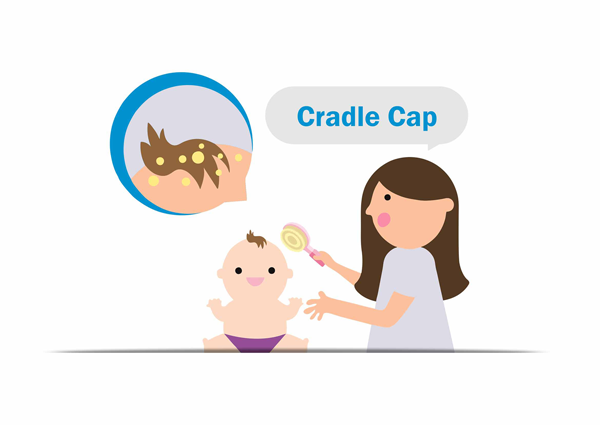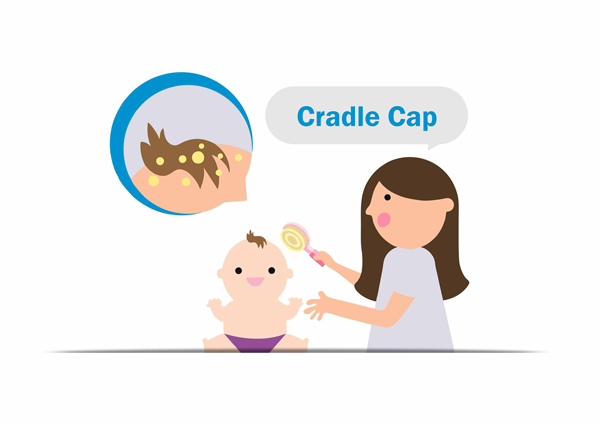Cradle Cap

Cradle Cap: Symptoms, Causes, Treatment & Prevention
Cradle Cap is a type of skin condition that develops in infants and is almost similar to seborrheic dermatitis seen in adults. In its milder form Cradle Cap causes little flaking of the scalp skin especially on the vertex part. Usually the condition is considered to be harmless and its gets cured by itself over time. However, when severe it can cause thick scaling and formation of crusts that can distress the babies. In this article you can learn about the causes, symptoms that help to spot Cradle Cap, and ways to prevent Cradle Cap in infants.
What is Cradle Cap?
Cradle Cap is a skin rash characterised by scaly, yellowish patches or crusts that develops on scalp of infants. It usually develops within the first few months after birth and is common in infants aged one to three months. It is similar to seborrheic dermatitis seen in adults. However, it does not cause much itching as with adult seborrheic dermatitis. Although Cradle Cap is not a very serious condition, the thick white or yellow scales are often difficult to remove from the infants scalp. Cradle Cap mainly affects the scalp but can also occasionally spread to other body parts such as face and diaper area.
What Causes Cradle Cap?
The causes of Cradle Cap are not completely understood yet. However, experts believe that Cradle Cap could be caused due to following reasons
- Excess activity of sebaceous gland on scalp skin: The hormones that are passed from the mother to the baby before it is born can contribute to development of Cradle Scalp. The hormones increase the production of sebum and so cause the rash on scalp. Excess of greasy sebum production on the scalp causes old skin cells to stay adherent to the scalp instead of falling off. Presence of fatty acids also causes excess turnover of scalp cells leading to the flakes.
- Fungal growth: Another cause of Cradle Cap is the fungus called Malassezia which is present in the normal bacterial flora of the skin. The fungus degrades sebum to release fatty acids. The fungus consumes only the saturated fatty acids as a food source and leaves behind the unsaturated fatty acids. However, the presence of fungus is a cause of Cradle Cap only in infants who show more susceptibility to it.
Should you be Worried About Cradle Cap?
The straight answer to this is No. Cradle Cap is generally a harmless skin condition and resolves on its own. And, so there is no need for much concern about the condition. It is not a contagious skin condition; it does not spread on close contact or on sharing items such as hair brushes, hats, caps bedding, towels, or other clothing items. The condition in infants may be caused due to hormones that increase sebum production or due to yeast or fungus present in the skin. Cradle Cap is not caused due to poor hygiene. However, the scaling on the scalp cannot be washed away easily from an infant’s head. Also, constant thick scaling and formation of yellow crusts can make the baby uncomfortable.
How Common is Cradle Cap?
Cradle Cap is a common skin condition in infants and the incidence is reported to be around 10 % in infants up to the ages of 1 month. Cradle Cap shows higher prevalence by 3 months of age affecting about 70 % of infants. The condition generally clears up by age 1 year and responds to some simple treatments. In infants aged 1 to 2 years, the prevalence is only 7%.
How to Treat Baby’s Cradle Cap?
Cradle Cap usually clears over time by itself. However, since the constant scaling of scalp skin can be a cause of distress to the baby or even the caretakers, simple treatment for Cradle Cap may be recommended.
- Massaging with mineral oils
Massage with baby mineral oil on the scalp helps to loosen up the scales and crusts. The oil should be left on the scalp only for 10 to 15 minutes followed by head bath using baby shampoo. After washing hair the scales can be brushed off using fingers or brush with soft bristle. The oil massage on scalp can be performed few times in a week. It is important to use only a mild and baby certified oils or shampoos for washing the scalp.- Topical steroids
If the scaling does not loosen up with oil massage or washing, simple steroid lotions can be applied to the scalp. It is necessary to use the steroidal lotion on baby’s scalp only after trichologist consultation. Topical steroids also help to reduce the scalp inflammation caused in Cradle Cap.- Medicated shampoos
At times trichologist may allow use of anti-dandruff shampoos. However, these can be extremely irritating to the eyes and hence needs to be used with care. Anti-fungal shampoo containing ketoconazole may be recommended in case of yeast or fungus being the cause of Cradle Cap.What does Cradle Cap Look like?
Crusty, yellowish patches on the scalp are the most prominent and obvious signs of Cradle Cap. Cradle Cap can look like,
Rashes: A scalp skin may show presence of red rashes with crusty, white or off white scaling
Scaly patches: The scaly patches may also be seen on other body parts such as forehead, ears, and eyebrows. The underarms and diaper area may also be involved.
Are There Any Tests for Cradle Cap?
There are no specific tests for Cradle Cap. The trichologist can usually spot Cradle Cap in new born by examining the scalp. When the Cradle Cap is spread to face or neck the rashes appear similar to what is seen in eczema in adults.
What Are the Best Ways to Prevent & Treat Cradle Cap?
Cradle Cap is usually self-limiting and may not require extensive treatment. However, experts have recommended some simple prevention and treatment options for Cradle Cap.
Prevention of Cradle Cap
- Apply mineral oil to the scalp with gentle massage.
- Regularly wash the scalp using mild baby shampoo even if the scales have cleared. Continue to use the medicated shampoo on trichologist’s advice so that the recurrence is prevented.
- Use soft hair brush to remove the scales if any
Treatment of Cradle Cap
- Topical antifungal medications
A lotion or cream containing antifungal medication called ketoconazole is safe in infants as it does not get absorbed in the body.- Use of mineral oils
Some experts recommend application of emollient creams or mineral or vegetable oils that help to soften scale. The oils should not be left in the scalp for more than 15 minutes or else it can worsen Cradle Cap. The oil massage can be followed by shampooing with medicated shampoos and brushing off the loosened scales.How to Spot Cradle Cap
Cradle Cap is easy to spot by white, off-white, or yellow coloured scales on the scalp. The rash develops within the first few months of life. The rash may also appear red in the beginning. It is often greasy but can also be dry. The scaling of skin can also be spotted on the face, especially the forehead, behind the ears, and along the eyebrows. In rare condition Cradle Cap rash can also be seen in underarms and diaper area.
What are the Other Conditions that Look Similar to Cradle Cap?
The signs and symptoms of Cradle Cap may be confused with other infantile skin conditions such as atopic dermatitis, and psoriasis if the rashes have spread to face.
When should you see the trichologist?
If the Cradle Cap does not improve with simple treatment at home you may need to take medical help. You must consult the trichologist if you notice that the symptoms of Cradle Cap worsen. The following are the signs that Cradle Cap is getting severe.
- The scaling starts causing itching and so the baby is in distress
- There is swelling or papule formed in the scalp
- The scaling causes bleeding from scalp skin
- The rashes get red and spread to face and neck





